Heating Elements
Heating elements are a part of our everyday lives. When we get out of bed and turn up the thermostat, take a hot shower, blow dry and curl our hair, brew coffee or tea, cook breakfast and toast bread we are making use of different types of heating elements. These elements are often hidden within the appliances and equipment we use, and we don't even see them at work.
Electric heating elements are components that convert electrical energy into heat energy. This heat energy can then be used to perform work. Heating elements are made of material sturdy enough to withstand repeated high and low temperature cycles without melting or breaking down. They use radiation, conduction or convection to increase the temperature of the surrounding solids, liquids or gas. For example, the heating element in a hair dryer transfers its generated heat through the air by using convection. The heating elements in a toaster transfer their heat to the bread using radiation in order to evaporate the water in the bread and create toast.
Quick links to Heating Elements Information
How Heating Elements Work
For a material to be considered for use in a heating element, it must resist electricity flow when a current is applied to it. The resistance is then converted from electrical energy to heat energy. The amount of heat energy produced is related to how much the material resists the electrical current applied. The resistivity of a given length of element wire is measured based on how much resistance there is per length and cross-sectional area, and it is measured in Ohms per meter. Ohms can then be used to calculate the kilowatt (kw) load of the element. Specific calculations are used to measure the resistivity of round element wires, tape elements, and coiled or spiral elements.
Applications That Use Heating Elements
Heating elements are useful in residential, commercial and industrial settings. Heating elements in the home can be found in the electric water heater, oven, furnace, radiator and clothes dryer as well as other small and large appliances. Commercial uses for heating elements include food warmers, fryers, steam tables, espresso machines, saunas and steam cleaners. Industrial heating elements are used in medical devices, pipe heaters, oil diffusion pumps, liquid immersion heaters, gas heating, kilns and curing. The food, glass, steel, ceramic and electronic industries are large consumers of heat element technologies.
The History of Heating Elements
Thomas Edison is credited with first using a carbon filament to create the incandescent light bulb in the late 18th century. Because the filament generated light at a high temperature, the invention of the first heating element is associated with him. However, the first heating elements developed specifically to generate heat did not come until later. In the late 19th century, James Prescott Joule and Julius Robert Mayer developed the first law of thermodynamics, which described a relation between heat and work. It was not long before inventors started applying this information to their creations. In 1868, a London painter named Benjamin Waddy Maughan invented the first gas water heater called a geyser. It was not safe to use in residential settings because it had no ventilation for the vapors produced. Not until 21 years later did the Norwegian-born American engineer Edwin Ruud invent the electric water heater.
While Albert Marsh is credited with inventing the first electric heater, he discovered chromel (now called NiChrome), an alloy of nickel and chrome, in 1905. It was 300 times hotter than competing elements, and was patented in 1906. Marsh's chromel was immediately used in electric heaters. In 1909, General Electric marketed its first successful toaster using Marsh's discovery. During this same century, tea kettles were electrified. First they had to be heated on coiled elements, but they were later designed with electric heating elements built into them.
American inventor Edward G. Acheson discovered silicon carbide in 1891. He was trying to invent artificial diamonds. What he created was one of the hardest synthetic materials in existence that can also function as a semiconductor. Silicon carbide can be found in heating elements used in high temperature applications. Fast forward to the 21st century, and heating elements have expanded to include many different materials, shapes, sizes and applications.
Heating Element Images, Diagrams and Visual Concepts
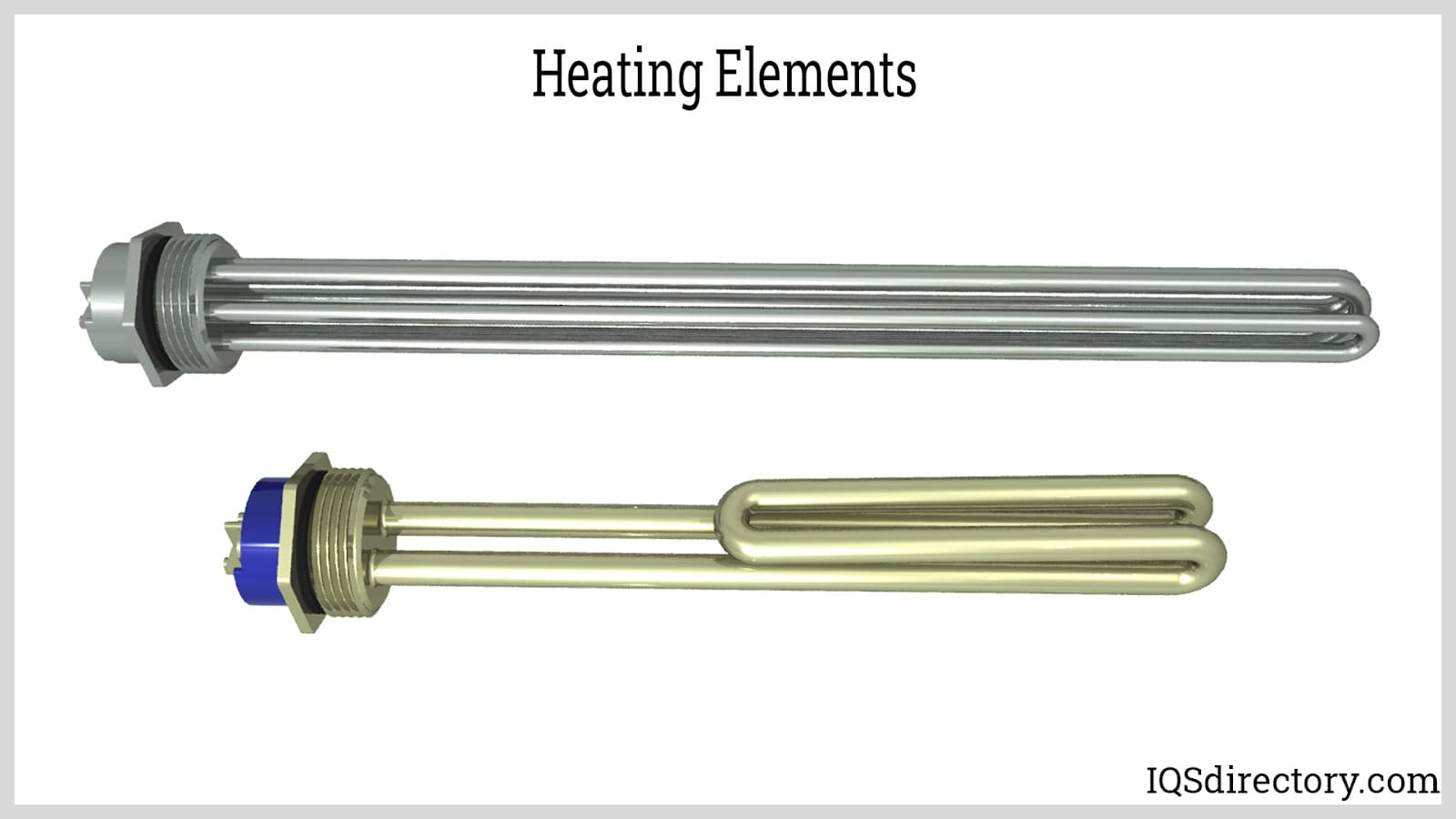 Heating elements materials or devices that directly converts electrical energy into heat or thermal energy through Joule heating.
Heating elements materials or devices that directly converts electrical energy into heat or thermal energy through Joule heating.
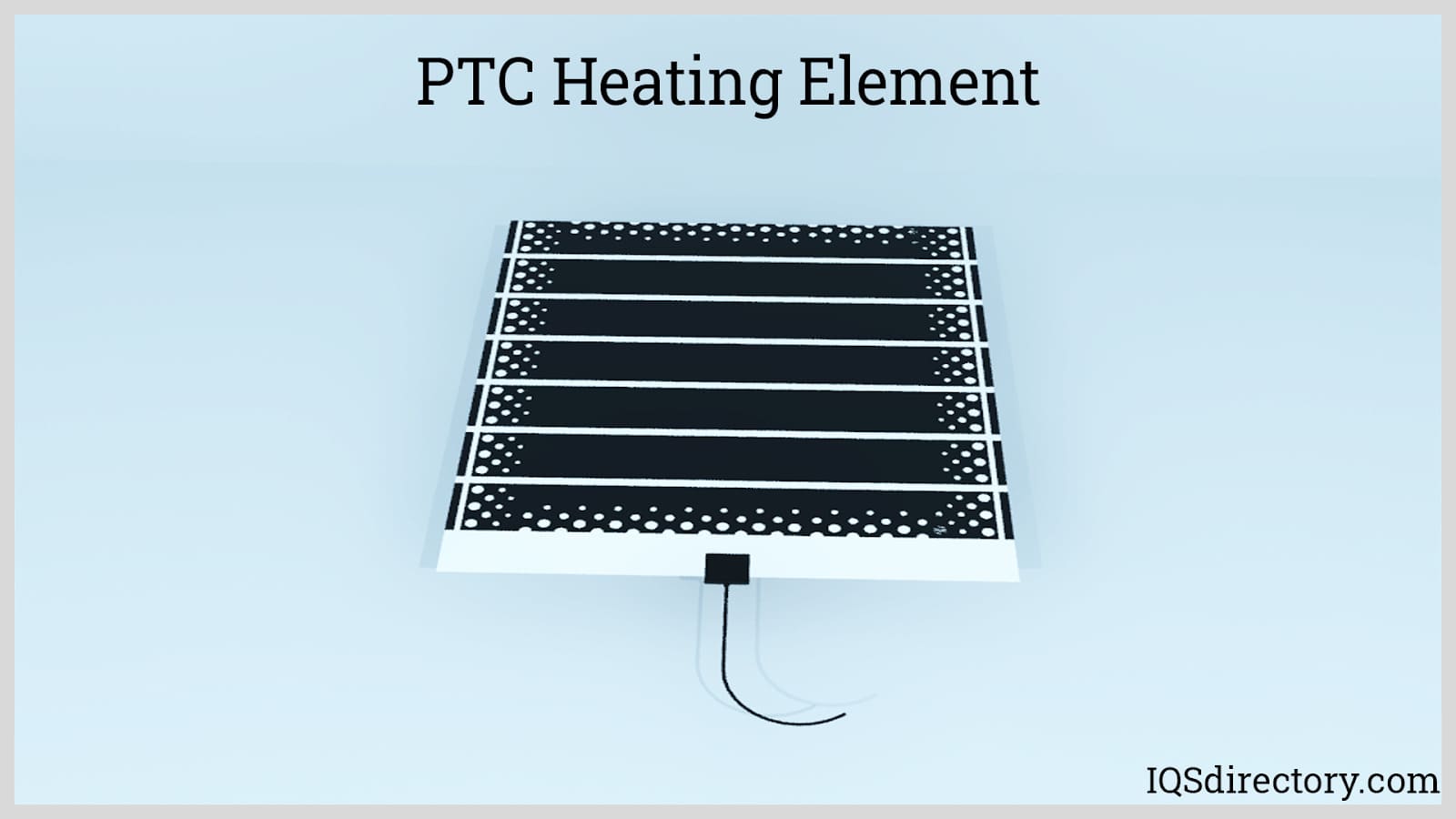 PTC heaters have a unique property which the heater maintains or limits the currents flow by having an increased electrical resistance as the temperature increases.
PTC heaters have a unique property which the heater maintains or limits the currents flow by having an increased electrical resistance as the temperature increases.
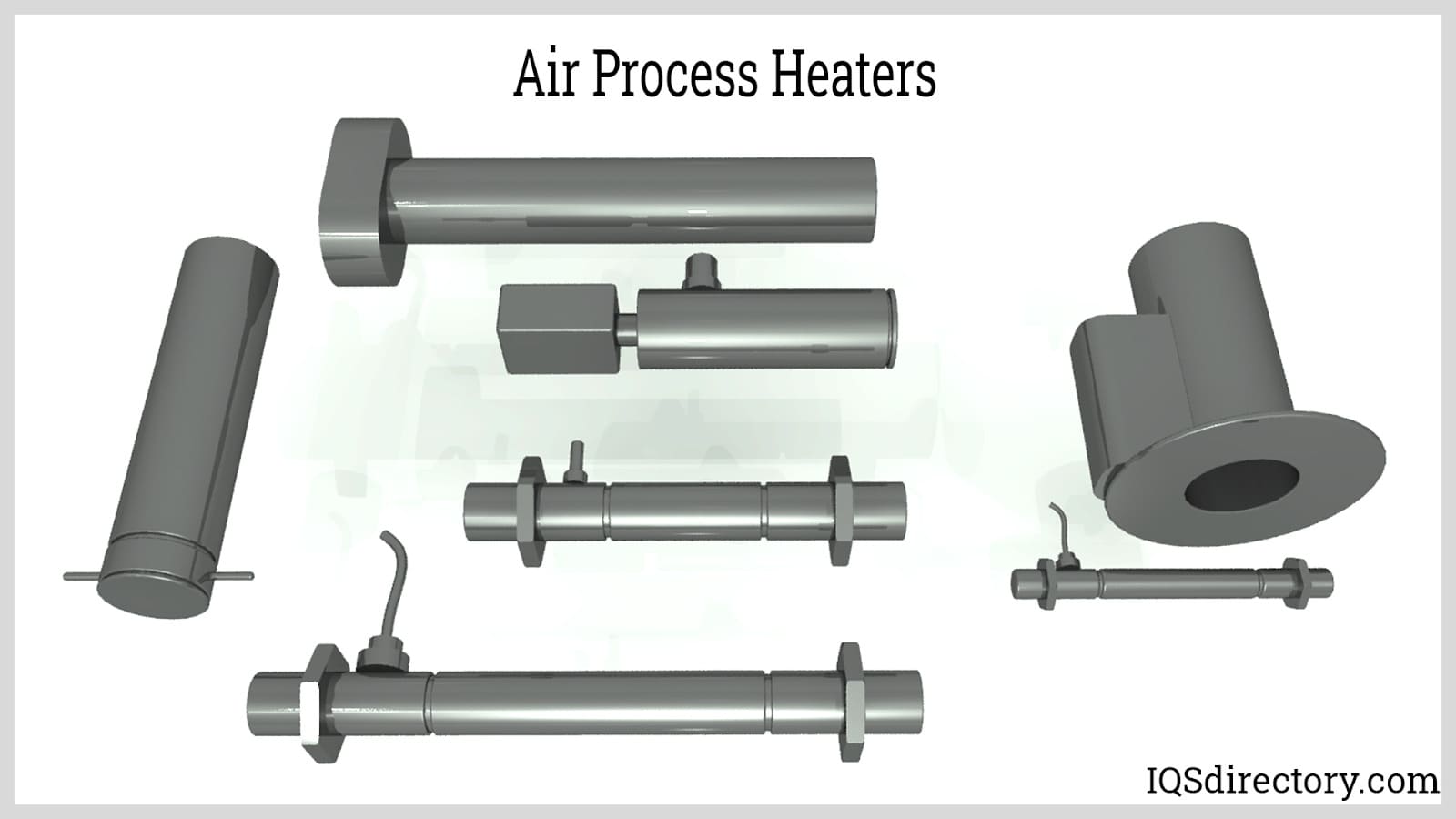 This type of heater heats up flowing air, the air is heated with a tube or pipe.
This type of heater heats up flowing air, the air is heated with a tube or pipe.
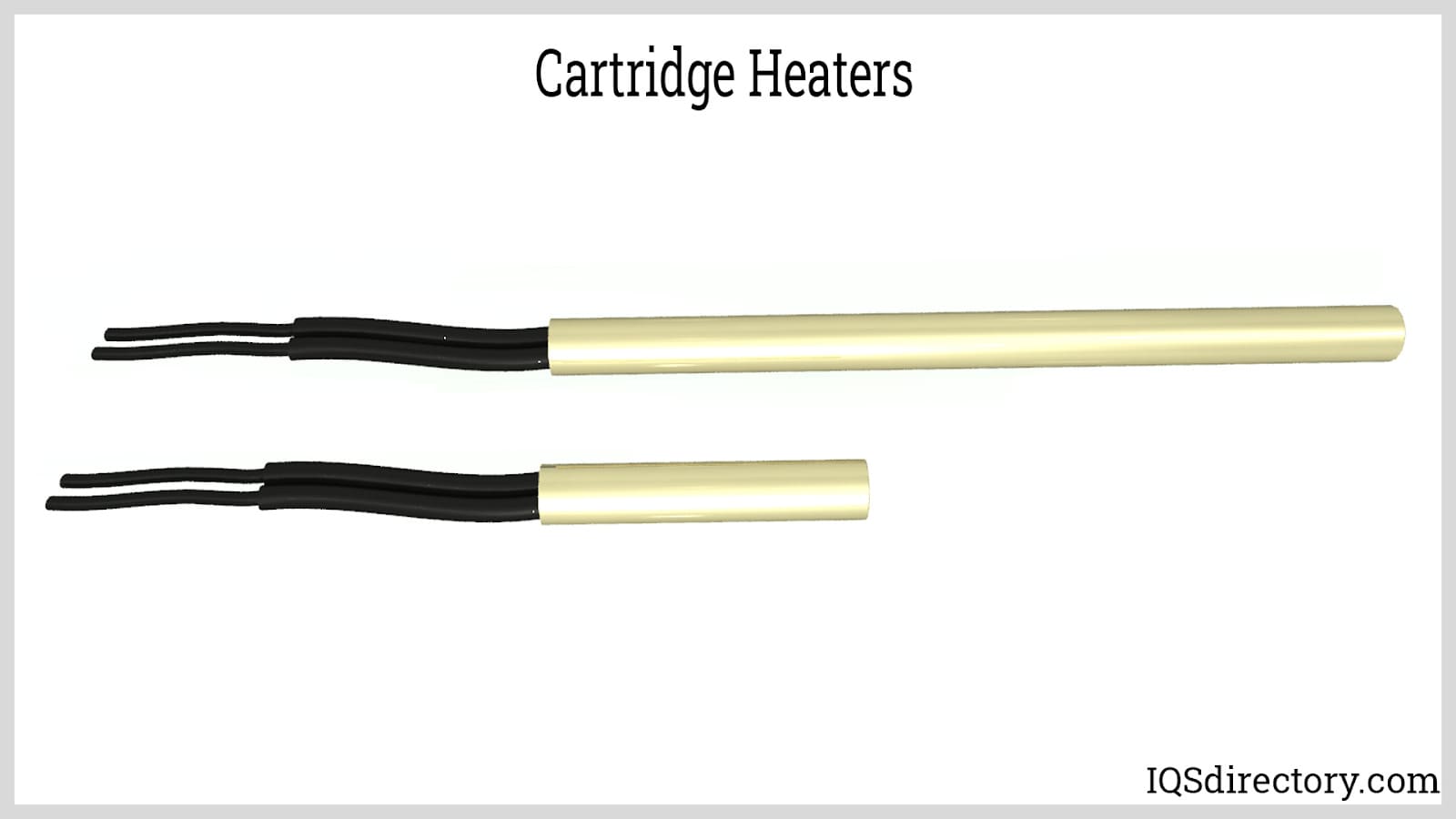 Cartridge heaters are a tube shaped heater with a resistance wire coiled around a ceramic core.
Cartridge heaters are a tube shaped heater with a resistance wire coiled around a ceramic core.
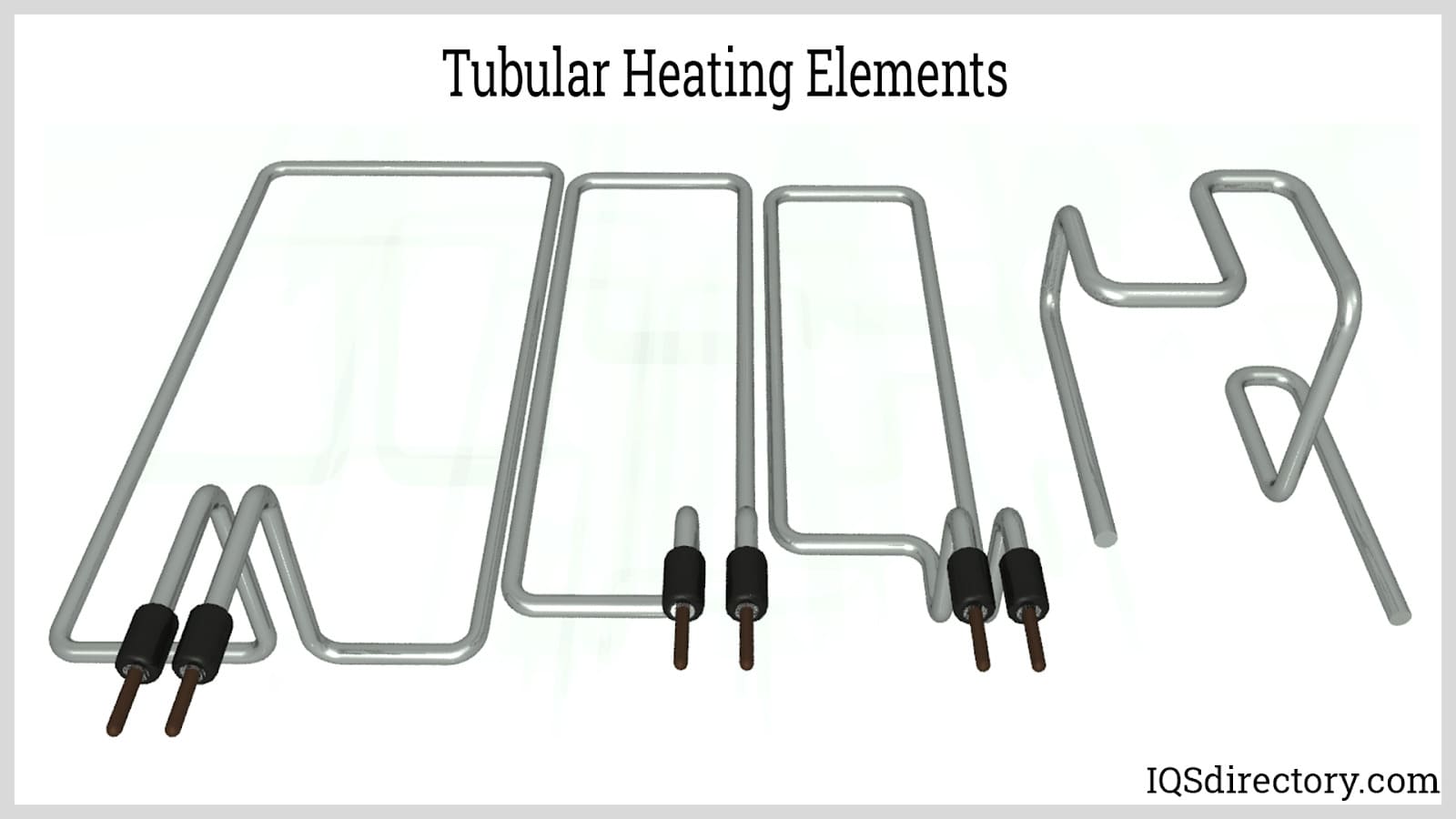 Tubular heaters are the same as cartidge heaters but the lead terminals are on the opposite ends of the tubing.
Tubular heaters are the same as cartidge heaters but the lead terminals are on the opposite ends of the tubing.
 Band heaters wraps around cylindrical metal surfaces which can indirectly heat fluids in inside the vessal.
Band heaters wraps around cylindrical metal surfaces which can indirectly heat fluids in inside the vessal.
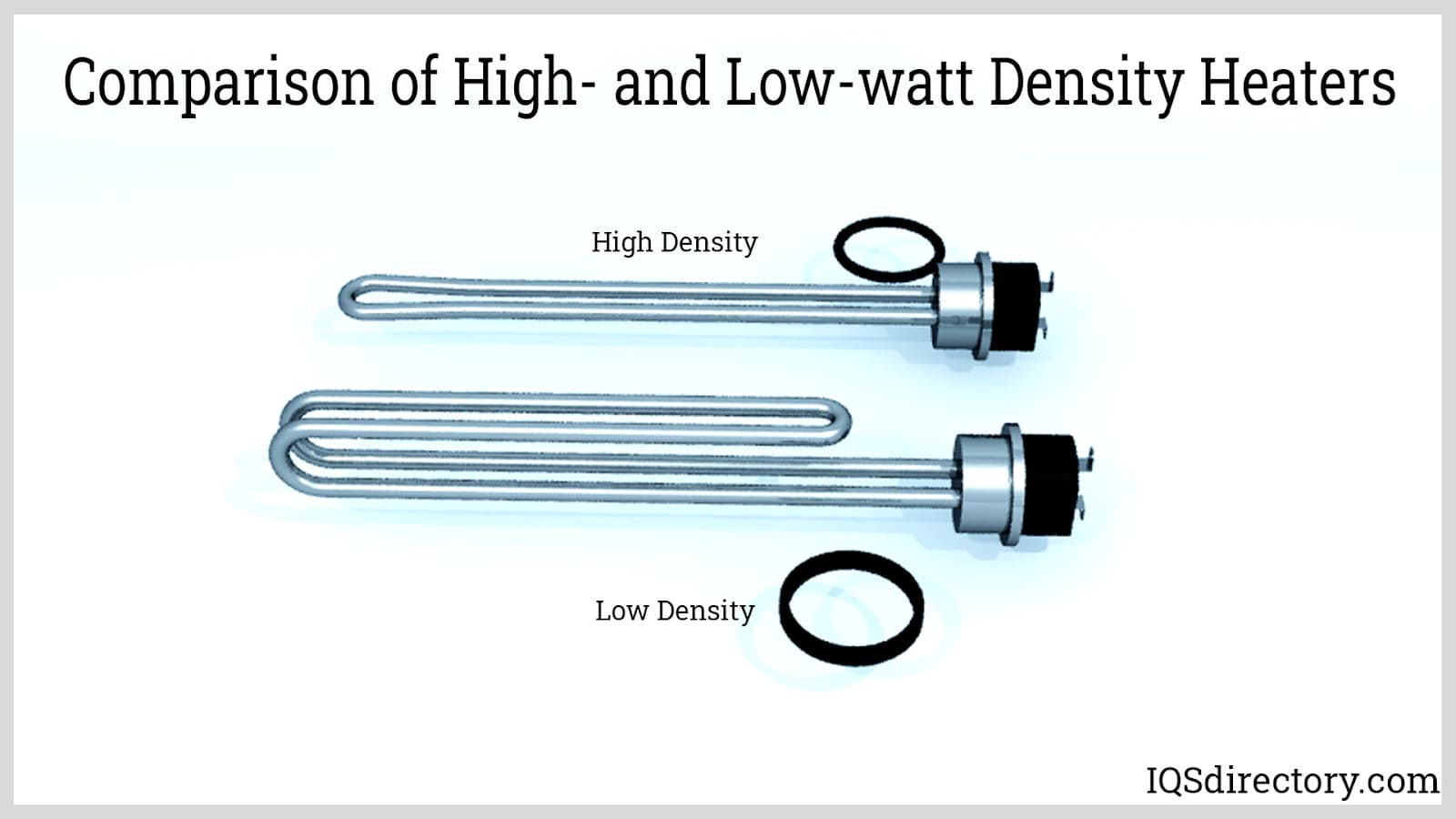 The right watt density must be used for specific application to utilize the service life of the heater.
The right watt density must be used for specific application to utilize the service life of the heater.
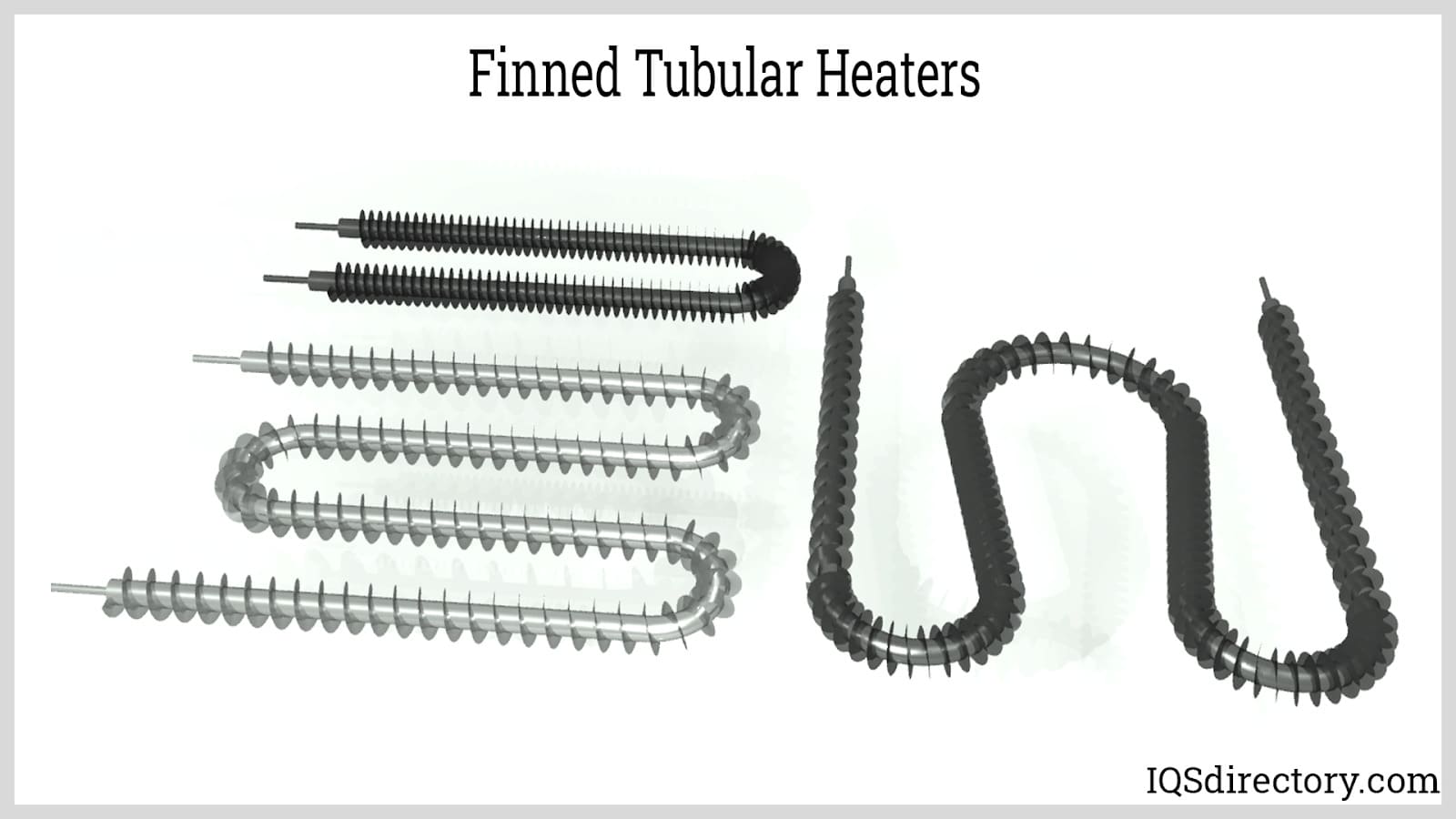 Finned surfaces and long wire coils are the usual features of air heaters, since stagnant fluids are easier to heat with a controlled temperature than flowing fluids.
Finned surfaces and long wire coils are the usual features of air heaters, since stagnant fluids are easier to heat with a controlled temperature than flowing fluids.
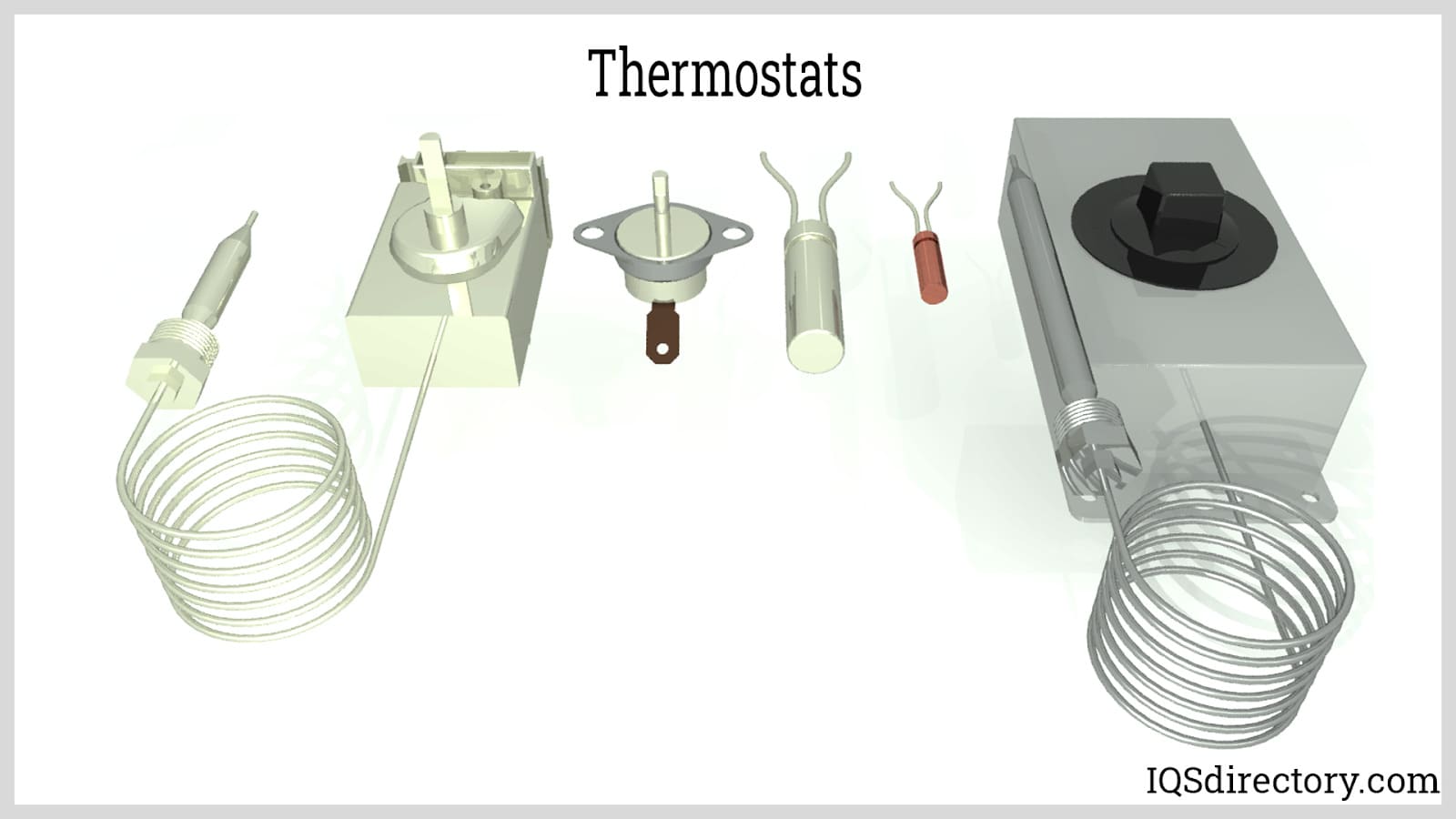 Conventional heaters have a temperature sensor and a therostat to adjust the temperature when needed.
Conventional heaters have a temperature sensor and a therostat to adjust the temperature when needed.
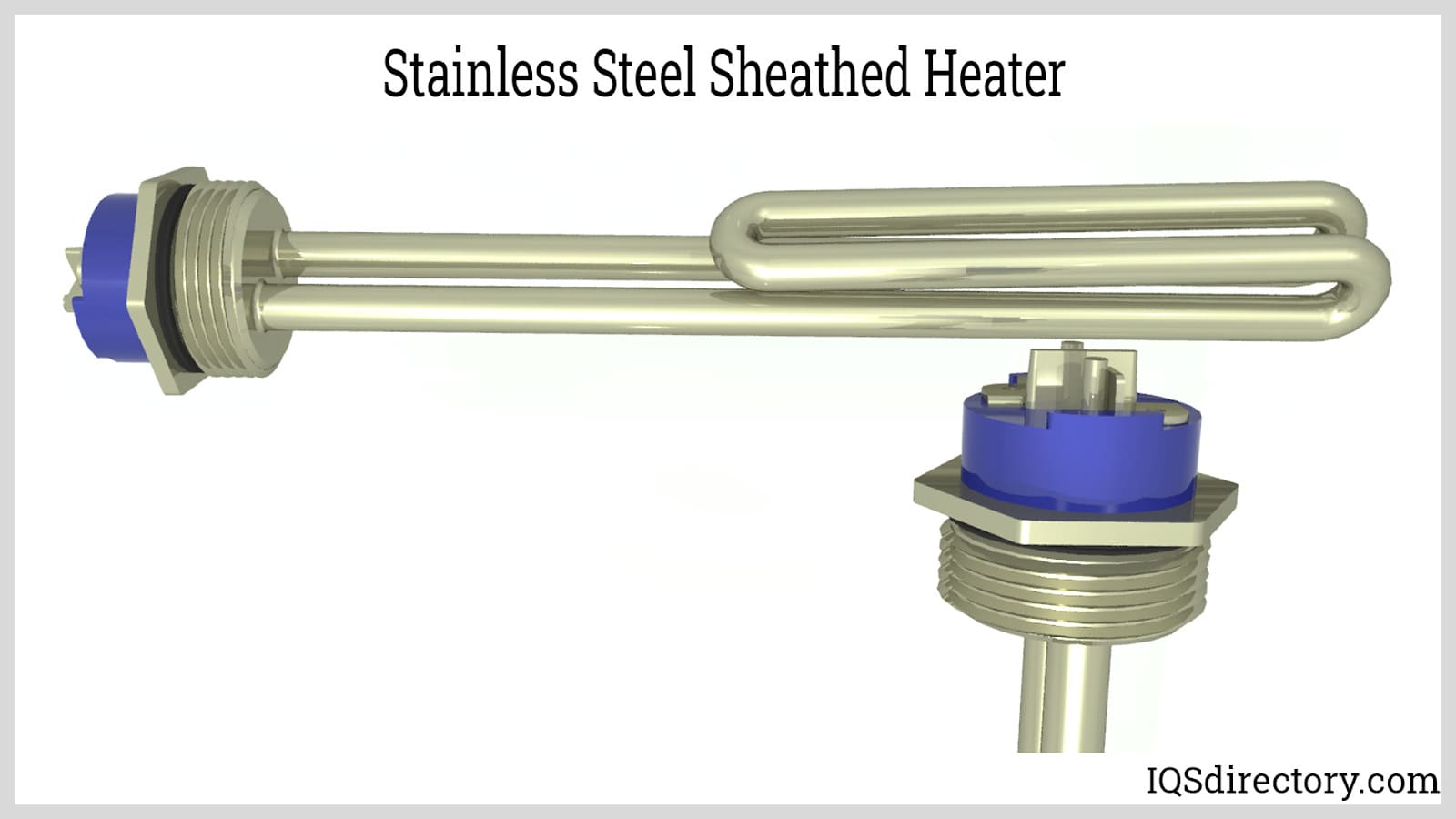 To avoid corrosion sheathing material is required using stainless steel, brass, copper, or other special alloys.
To avoid corrosion sheathing material is required using stainless steel, brass, copper, or other special alloys.
Heating Element Types
- Cable Heating Elements
- Made of wire that is wound on a fiberglass core and insulated by PVC or silicone rubber.
- Cartridge Heating Elements
- Devices which provide localized heating for a wide range of applications. These heaters are generally inserted into a substance or are positioned to heat a certain area. These items are typically manufactured from seven different parts including: heating coil, insulation, sealing, sheath, watt density, lead wire type and termination.
- Ceramic Heating Elements
- Used in low and high temperature ovens and furnaces. They can be found in rectangular, square, flat, cylindrical or partial cylinder shapes.
- Coil Heating Elements
- Common in many products and provide heat to a general area. The heating elements are shaped into coils based on their intended purpose; they can be free radiating or enclosed.
- Dryer Heating Elements
- Metallic components that conduct heat in many products, including clothes dryers and hair dryers.
- Electric Heating Elements
- Heating elements used inside devices that use electricity to power themselves and create heat.
- Flexible Heating Elements
- Very thin elements that allow for bonding to various shapes and compounds in order to provide heating directly where it is required.
- Heater Elements
- The heating component within all electric heaters used for solid-to-gas/liquid heating and solid-to-solid heating
- Heating Coils
- Configured to have a large surface area without taking up much space.
- Immersion Heater Elements
- Allow for the electric heaters to be immersed in the liquid or gaseous materials that it is heating.
- Industrial Heating Elements
- Convert electrical energy into heat energy and then transfer that heat energy to air, liquid or solids through convection or conduction.
- Infrared Heating Elements
- Used in infrared heaters, which are used for many applications. The element heats a surface, which distributes the heat.
- Mica Elements
- Often encapsulated in steel sheaths and have ribbon or wire wound on mica sheet or tube and are insulated by mica.
- Plug or Rack Type Heating
- Typically used in convection furnaces and ovens with open coil heaters. Plug/Rack types are often an assembly of heating elements together in a rack or plug.
- Quartz Heating Elements
- Typically used in infrared heaters and provide a source of rapid heating.
- Silicon-Carbide Heating Elements
- Used in high temperature procedures and where higher watts are required. They are usually long tube-like elements.
- Tubular Heating Elements
- Very common and sometimes have a casing or protective component and can be formed according to the application.
Materials Used to Manufacture Heating Elements
- Manufacturing With NiChrome
- Those made of NiChrome are composed of an alloy of 80% Nickel and 20% Chromium. The flexible NiChrome makes it easy to form the element into whatever shape and size is needed for its application. The 2550 degree Fahrenheit melting point of NiChrome and its resistance to oxidation also make this a popular material for heating elements. NiChrome strips, wires, and/or ribbons can be found in toasters, hair dryers and clothes dryers. NiChrome heating elements can be designed to reach a maximum temperature of 1300 degrees Fahrenheit.
- PTC Ceramic
- Portable ceramic space heaters are popular in homes and offices. These use a PTC (Positive Temperature Coefficient) ceramic element to generate heat. Instead of using wire, PTC ceramic heating elements use ceramic chips or stones made of a barium titanate or lead titanate composite. The use of ceramic helps make the product safer and last longer. A ceramic element is safer because it runs at 518 degrees Fahrenheit, compared to the 900 degree Fahrenheit running temperature of a traditional metallic element.
- Silicon Carbide
- Elements made of silicon carbide, or SiC, can operate at a higher temperature and watt load than its metallic counterparts. They can reach 1625 degrees Celsius (2927 degrees Fahrenheit), and come in standard or customized designs. Because of the hardness of SiC elements, they do not lose their shape at maximum temperatures. This allows them to be integrated into equipment design without the structural supports needed with elements made of other materials.
- Molybdenum Disilicide
- Also called MoSiO2 and MolyD, heating elements can reach as high as 1850 degrees Celsius, or 3362 degrees Fahrenheit. They are used in electric furnaces used in the electronic, steel, ceramic and glass industries.
- Quartz in Heating Elements
- Because quartz can aid in heat transmission from the core of a heating element and it can transfer heat with little absorption, it is a popular choice among designers. Quartz elements heat rapidly and they are used in infrared heaters. Common industrial applications of quartz heating elements are paint drying, film curing, thermoforming and adhesive sealing.
- Stainless Steel
- Useful in water immersion applications. Kettles and beer brewing equipment use stainless steel because it does not rust, even when exposed to water for long periods. Electric brewers using elements made of material other than stainless steel require a magnesium anode to prevent the element base from rusting.
- Mineral Insulation
- Can be used depending on the desired application of the heating element. A benefit of using mineral insulation is that the coating oxidizes and provides protection from further damage over time. Fiberglass, magnesium oxide and mica are all used for this purpose.
Customizing Heating Elements
Heating elements can be customized for specific uses. They can be made of nickel, iron, molybdenum and ceramic. The configuration can be of wire, tape (ribbon), coil, chips or stones. The planned application determines the size and shape of the heating element needed. For example, the elements on an electric stove top and in the base of a kettle need to be coiled and industrial immersion heaters are bent into a hairpin shape. Tubular elements are used in electric ovens, grills, diffusion equipment, water immersion heaters and kettles. Mica-wound elements can be found in band heaters and toasters. Convectors and fan heaters use spiral heating elements. A flexible heating element can be configured to fit highly specialized equipment in the medical, aviation and automotive industries. Typically constructed of etched foil, flexible heating elements can be used in LCD displays, optical equipment, PC boards in computers and applications that protect outdoor devices from freezing.
Heating Element Maintenance
Heating elements usually fail before their surrounding equipment does. Sometimes it is more cost effective to replace the appliance or equipment than it is to replace the heating element. This is the case with hair dryers, toasters and small space heaters. At other times it is desirable to replace the element for further use of its equipment. This is the case with water heaters, furnaces and ovens. The wire diagram found on the equipment aids in removing old elements and installing and rewiring new elements. An electrical box may require opening, as they are used to connect heating cables to other cables as well as to the power source.
In addition to the heating elements some accessories are required for safe and proper use. For example, water heater elements require a silicone o-ring to form a proper seal. Braided wires, clips and bolts are used in electric furnaces. Electrical boxes, power cords, extensions and adapters are used in different applications as well.
Standards and Specifications for Heating Elements
UL (Underwriters Laboratories) compliance is required of all heating element manufacturers to ensure safe use. The UL 197, UL 499 and UL 1030 standards apply to commercial electric cooking appliances and electric heating appliances. Design specifications of electric sheathed heating elements must comply with the standards to receive approval. Electric duct heaters must meet UL 1996 to be in compliance.
The National Electrical Code (NFPA 70) provides standards for the installation of electric wiring, which includes heating elements. While it is not federal law, many states have adopted its guidelines.
Things to Consider Before Selecting a Manufacturer
There are many good heating element manufacturers. Selecting the right manufacturer is a matter of the customizations and intended use of the heating elements needed. For example, toasters require small exposed NiChrome tape or ribbons, radiators use long bars, some space heaters use PTC ceramic and diffusion pump heaters require a specialized process.
When choosing a manufacturer, it is important to ensure their ability to meet customer needs while maintaining industry standards and regulations. They must know which types of elements are appropriate for which applications. Using an inappropriate heating element can result in damage to the product, fires, short circuits and equipment loss.
Many considerations must be addressed prior to choosing a manufacturer. Are most of their products and parts designed for residential, commercial or industrial use? Are they in compliance with UL standards? Can the prospective manufacturer produce heating elements for a specified temperature range and of a desired material? Do they know the industry standards for heating elements in different applications? What does their maintenance service include? Do they provide a warranty for any elements and related parts purchased from them? What is their reputation in the industry for response time when replacement elements are required? The answers to all of these questions and more must be clear before moving forward. Selecting the right manufacturer and maintenance schedule will encourage product safety and improve its longevity. For a convenient list of heating element manufacturers, you can visit the top of this page.
Heating Element Terms
- Alloy
- A substance made of two or more metals or of a metal and a non-metal that are fused together while molten.
- Annealing
- To heat and then cool a solid (usually steel or glass) for softening, cooling slowly in a furnace to result in a less brittle material.
- Brazing
- The joining of metals through the use of heat and a filler metal to form a strong joint, the filler metal is usually silver alloy.
- BTU
- British Thermal Unit. The amount of heat required to raise or lower the temperature of one pound of water one degree Fahrenheit.
- Carburizing
- To combine, often a metal, with carbon.
- Celsius
- The metric temperature scale in which water freezes at zero degrees and boils at 100 degrees, designated by the symbol "C".
- Ceramic
- Any product made from a nonmetallic mineral (clay) by firing at a high temperature, examples: porcelain or brick.
- Coil
- Any coiled element that serves as the source of heat.
- Condenser Coil
- In a heat pump system, the coil absorbs heat from the outdoors.
- Ductwork
- A pipe or conduit through which air is delivered. Ducts are typically made of metal, fiberboard or a flexible material.
- DX
- Direct expansion; a system in which heat is transferred by the direct expansion of refrigerant.
- Fahrenheit
- The temperature scale on which water freezes at 32 degrees and boils at 212 degrees; it is designated by the letter F.
- Firebrick
- A brick that can withstand high temperatures and is used specifically for lining furnaces or fireplaces.
- Grounded Element
- An element that has broken and is touching something metal, like the cage that is supposed to hold the element or the element metal housing.
- Heating Element
- The component of the heater that is responsible for conducting the heat.
- Infrared
- Invisible waves, sensed as heat, which has lengths longer than red visible light and shorter than microwaves.
- Kilowatts
- Unit of measurement of energy 1000 watts.
- Mica
- A mineral made of shiny, transparent, flat chemical crystals. It is often used as an electrical insulator.
- Plenum Chamber
- A space or ducting used to distribute the air evenly in the process of cooling, heating, or humidifying.
- Surface Load
- Can be determined by dividing the total bearing load by the bearing projected area (inner diameter * width).
- Therm
- A measurement of heat equal to 100,000 btu.
- Thermocouple
- Measures the difference in potential created at the junction of two different metal wires that feed from the measuring instrument.
- Thermostat
- A device for controlling temperature.
- Watts
- The meter-kilogram-second unit of power equal to the power produced by a current of one ampere across a potential difference of one volt, 1/746 horsepower.